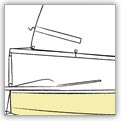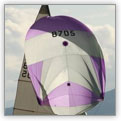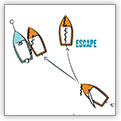Need that little bit of extra speed to give you the edge? See if we have any techniques that might help!

Sailing is a pastime that depends on the elements, which are sometimes hard to predict, and don’t always play by the rules. From when you rig up, to setting sail, to a few hours later, the weather and wind in particular can completely change, and you need to be able to adapt to changing situations.
- Read More

In the previous articles in this series, we’ve covered a number of topics, including rigging, hoisting, flying and dropping, both for asymmetric and symmetric spinnakers. Now we’re going to cover a few other important issues that haven’t cropped up along the way.
- Read More

Coming alongside is necessary whether you like it or not, but not as hard as it may sound! You’ll use coming alongside for a number of things, such as coming up alongside a power boat, another sailing dinghy, jetty, or similar techniques are used for picking up a mooring, or retrieving a man overboard – the basic underlying technique is the same for all of the above.
- Read More
| More articles |
|---|
| Dropping a Symmetric Spinnaker - So you’ve hoisted it, sailed it, and are nearing the end of the lake, or the mark to go around, so you need to drop that spinnaker. Easy – just let go of all the ropes! Or not – you need to drop it carefully, and pack it away so it’s ready for the next time you want to hoist it. |
| Dropping an asymmetric spinnaker - So you successfully hoisted the spinnaker, flew it on a relatively downwind course, and are fast approaching the leeward mark, to head upwind again, so that spinnaker needs to come down, quickly! What do you do? |
| General Tips for Spinnakers - In the previous articles in this series, we’ve covered a number of topics, including rigging, hoisting, flying and dropping, both for asymmetric and symmetric spinnakers. Now we’re going to cover a few other important issues that haven’t cropped up along the way. |
| Hoisting a Symmetric Spinnaker - Once you’ve rigged your symmetric spinnaker onto your boat, you’re ready to go sailing! Whether you’re racing or just having a practise, the hoisting procedure is the same – however – it does differ depending which side of the boat you hoist on. |
| Hoisting an Asymmetric Spinnaker - Asymmetric spinnakers are easy to hoist, and require little messing around with poles - it's usually just a one or two line job to hoist! |
| Introduction to Asymmetric Spinnakers - Asymmetric spinnakers are easier to handle than their older counterpart, but they do require a different approach to sailing them. |
| Introduction to Spinnakers - Spinnaker sails are used to gain extra speed when sailing downwind. Find out what types are available, when you should use them, and how to use them in our series of article on spinnakers. |
| Introduction to Symmetric Spinnakers - Symmetric spinnakers are used to sail down wind and are made with a very full shape and large belly to act like a kite to catch the wind, hence their nick name “sailing the kite”. |
| Rigging a Symmetric Spinnaker - Rigging a symmetric spinnaker isn’t too difficult – it’s just a case of making sure you get the lines in the correct places. Check out our photo guide to get it right next time you try. |
| Rigging an Asymmetric Spinnaker - Asymmetric spinnakers are easier in all aspects than symmetric spinnakers, including when rigging, due to the lack of a spinnaker pole. |
| Sail Trim and Sail Settings - Find out how to set your sails set correctly for the conditions you are sailing in. |
| Sailing a Symmetric Spinnaker - Now you have that spinnaker hoisted, you need to do something with it. Unlike asymmetric boats, the point of a symmetric spinnaker is to sail downwind. |
| Sailing an asymmetric spinnaker - So you have that nice big spinnaker hoisted up the mast, what next? If you try sailing downwind in an asymmetric boat, you’re just wasting lots of money spent on it. So what should you do? |
| Seamanship - Anchoring - For the racers amongst you, anchoring is something you’ll probably never do. However, if you plan to start going out day sailing around the coastline, it’s a really important skill to perfect. |
| Seamanship - Coming alongside - Coming alongside is necessary whether you like it or not, but not as hard as it may sound! You’ll use coming alongside for a number of things, such as coming up alongside a power boat, another sailing dinghy, jetty, or similar techniques are used for picking up a mooring, or retrieving a man overboard – the basic underlying technique is the same for all of the above. |
| Seamanship - Reefing Afloat - Sailing is a pastime that depends on the elements, which are sometimes hard to predict, and don’t always play by the rules. From when you rig up, to setting sail, to a few hours later, the weather and wind in particular can completely change, and you need to be able to adapt to changing situations. |
| Seamanship - Sailing Backwards - The ability to sail backwards may not sound very useful, but it’s a skill that contributes towards boat control and manoeuvrability. |
| Seamanship - Sailing without a Centreboard - Several seamanship skills are firmly centred around helping you deal with, or sail in, what are termed adverse conditions; this is usually when something is not working properly. Centreboardless sailing is one of these skills. |
| Seamanship - Towing - Towing, in sailing terms, can mean one of two things. Either you are towing someone (in which case you will usually be in a powerboat doing the rescue) or you are being towed. We’ll talk about both. |